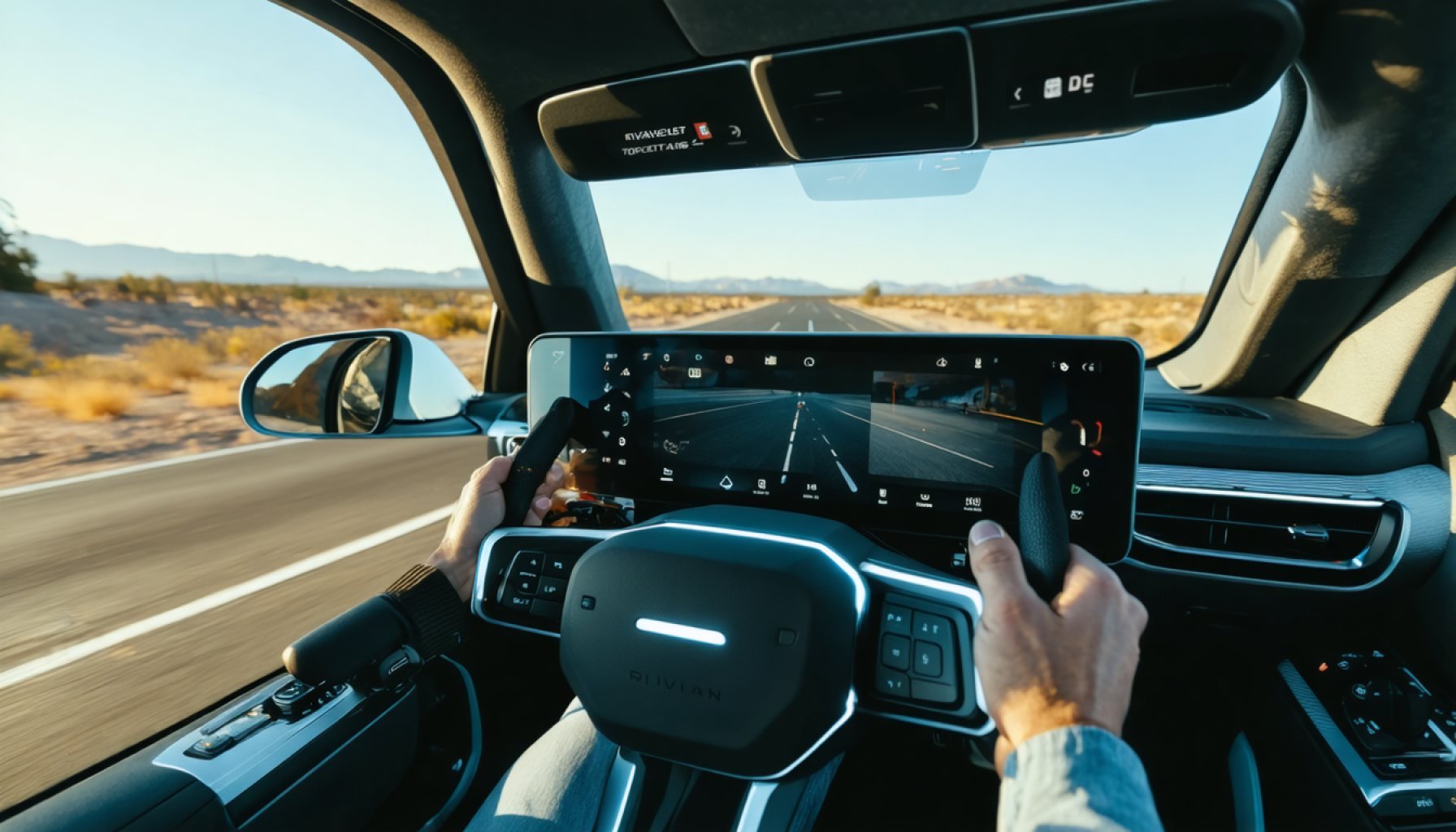- Rivian is launching a hands-off driver assistance system for highways soon, with plans for an “eyes-off” version by 2026.
- The company aims to compete with industry leaders like Ford and General Motors, who offer similar autonomous driving technologies.
- Unlike Tesla’s system that requires driver engagement, Rivian seeks to provide greater freedom to users on highways.
- Rivian’s focus shifted back to innovation after navigating a challenging year with a successful cost-cutting strategy and increased software sales.
- Founder RJ Scaringe has long envisioned autonomous vehicles, but priorities shifted due to the company’s IPO and vehicle launches.
- Rivian is using sophisticated data-driven training methods to develop its autonomous system, reminiscent of Tesla’s approach but uniquely adapted.
- Future plans include expanding autonomous features beyond highways and finding cost-effective ways to harness necessary computing power.
Rivian is steering boldly into the world of autonomous driving. In a move that lights up the road ahead, the automaker plans to release a hands-off driver assistance system for highways within weeks, setting the stage for a more ambitious “eyes-off” version by 2026. This technological leap will position Rivian alongside industry giants like Ford and General Motors, who have already embraced similar systems with enthusiasm.
While Tesla’s Full Self-Driving system keeps drivers tethered to the wheel, Rivian envisions a future where their users can enjoy highways with newfound freedom. Having recently navigated a tumultuous year—punctuated by a successful cost-cutting strategy and an upward swing in software sales—Rivian now finds itself with room to innovate.
Rivian’s autonomous goals have long been part of its DNA, with founder RJ Scaringe imagining a world where Rivian vehicles seamlessly travel on their own. Yet the practical steps to that vision took a backseat as the company focused on its IPO whirlwind and the complex birth of three new vehicles.
Now, with its feet firmly on the ground and deals like its recent partnership with Volkswagen boosting its sails, Rivian is laying down the tracks for innovation. Employing sophisticated “end-to-end” training techniques, Rivian draws on mountains of data from cameras and sensors to forge its hands-off driving system, echoing Tesla’s own approach but with a nuanced twist.
Scaringe envisions these features expanding beyond highways, ultimately ushering in an era where hands-free and eyes-off driving becomes the norm across all roads. As Rivian accelerates towards this future, they’re exploring inventive ways to access the computing power needed without hefty expenditures, diverging from Tesla’s strategy.
Rivian’s journey is an eloquent reminder: true innovation requires patience, vision, and a touch of daring.
Unlocking the Future: Rivian’s Bold Steps in Autonomous Driving
How-To Steps & Life Hacks
For Rivian owners anticipating the upcoming driver assistance system, here is how you can prepare:
1. Stay Updated: Regularly check for software updates through your Rivian app or vehicle interface. These updates will likely include the new driver assistance features.
2. Understand Your Vehicle: Familiarize yourself with existing sensors and cameras on your Rivian vehicle to appreciate how the system will use these for autonomous functions.
3. Practice Patience: Begin using the system in low-traffic areas to get comfortable before attempting longer highway drives.
4. Review Guidelines: Always read the manual to understand system limitations and ensure compliance with local laws regarding autonomous driving.
5. Feedback & Engagement: Participate in any Rivian feedback programs to assist in system evaluations and improvements.
Real-World Use Cases
Rivian’s hands-off system could revolutionize long-distance travel by reducing fatigue and increasing safety. Fleet management companies might also leverage these features to optimize delivery routes and schedules.
Market Forecasts & Industry Trends
By 2026, the autonomous vehicle market is projected to surpass $60 billion (Fortune Business Insights). Rivian’s system anticipated in this timeframe is likely to capture significant market share amidst growing competition from companies like Tesla, Ford, and GM.
Reviews & Comparisons
Early user experiences will likely compare Rivian’s system to Tesla’s Full Self-Driving and GM’s Super Cruise. Expect discussions around comfort, ease of use, and safety reliability.
Controversies & Limitations
As with any autonomous system, safety concerns remain paramount. Challenges include ensuring robust system security against hacking and addressing ethical considerations regarding decision-making in emergencies.
Features, Specs & Pricing
While specific pricing details for Rivian’s driver assistance system remain undisclosed, they typically function as optional add-ons and may vary based on vehicle model. Industry trends suggest a premium on cutting-edge automation features.
Security & Sustainability
Rivian is expected to prioritize cybersecurity measures to protect user data from hacking attempts and ensure system resilience. Their commitment to sustainability is echoed in their use of electric vehicles.
Insights & Predictions
Rivian might expand partnerships with tech companies to enhance their autonomous technology further, potentially focusing on expanding their capabilities beyond highway systems to urban settings.
Tutorials & Compatibility
Rivian’s system will presumably be compatible across its newer vehicle lineup, utilizing OTA (over-the-air) updates for seamless integration. Tutorials might be available via their app or official website to facilitate user adoption.
Pros & Cons Overview
Pros:
– Reduces driver fatigue on long trips
– Enhances route efficiency for fleets
– Keeps Rivian competitive with technological advances
Cons:
– Possible high initial cost
– Reliance on external data to improve
– Potential legal and ethical hurdles
Actionable Recommendations:
– Subscribe to Rivian’s newsletter for updates on new system features.
– Invest time in learning and adapting to autonomous technologies to ease your transition.
– Engage with community forums to share experiences and insights.
Quick Tips:
– Always keep manual control capabilities in mind.
– Regularly monitor Rivian communication channels for beta testing opportunities.
– Adhere strictly to the guidelines for a safe transition to autonomous driving.
For more official updates, visit the Rivian website.

